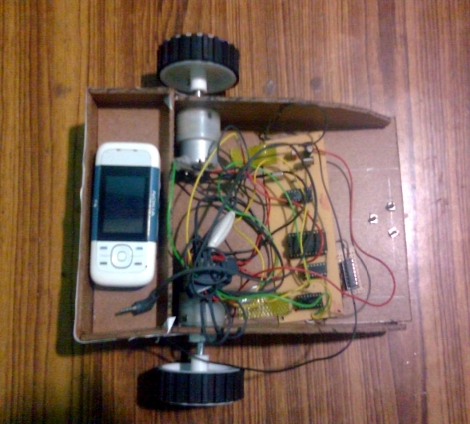
Nope, no microcontroller here, just a full-blown cellphone used as the brains of this little robot. The secret behind how it works is in the sounds the phone makes. The touch tones, known as DTMF, are monitored by the circuit mounted on the front half of the chassis and are responsible for driving the motors.
[Achu Wilson] built the circuit around an MT8870 chip which decodes the DTMF sounds and uses the BCD output to feed some logic chips. A 4 line to 16 line decoder and an inverter chip format the signals for use as inputs to the L293D motor driver. The video after the break shows him driving the rover directly by pressing number on the phone (like a tethered remote control). But he mentions that it’s possible to call the phone and press the numbers remotely. We assume you need to connect the call manually as we see no way to automatically answer calls.
This is certainly a fun way to play around with the DTMF protocol.















“We assume you need to connect the call manually as we see no way to automatically answer calls.”
Second paragraph: The mobile phone kept in the car is to be kept in automatic answering mode. It will cause the phone to automatically attend an incoming call. After the call is attended, one can easily control the car by through his phone.
Nice job reading the article, HAD.
I did this with an RC car not too long ago. I used Androids SL4A for the most part since it has built-in methods to generate DTMF. That way you could call the phone, or use your laptop and a python script to control it. Coupled with IPWebcam app, you have a video feed too.
One small problem I had, is that the 4bit values wouldn’t reset to 0’s when no tone was detected, would just stay on the last detected tone.
dial a 0 to stop all motors?
“We assume you need to connect the call manually as we see no way to automatically answer calls.”
With the Jack plug plugged in the phone will be in headset mode so can be set to auto answer calls..
Now that is awesome. I wish people would build more projects like this without any microcontrollers. They’re neat and awfully handy, but this is just cool.
Also, the L293D is an excellent chip.
if you can issue the hayes AT command-
ats0=1
this will auto answer phone/modem on first ring.
execellent!
i love this project :)
one thing though…
isnt the MT8870 secretly a uC with permementaly
burned code at the factory?
as ive only run accross ONE chip in my entire lifetime and the only place to get em is in REEEALLY old answearing machines (for remote control by telephone to check messages after password, much like this project)
yes i know you can buy anything online…
im talking about in REAL life
just answeared my own question: yes MT8870 *_IS_* a uC in disguise… why else would a LOW-SPEED “logic device” need a multi-MEGAHERTZ crystal oscillator ??? i mean audio frequescies… 3 MHz ??? could the OSC be soemthing like 32khz and be accurate enough to decode DTMF?????? unless its a uC!!!